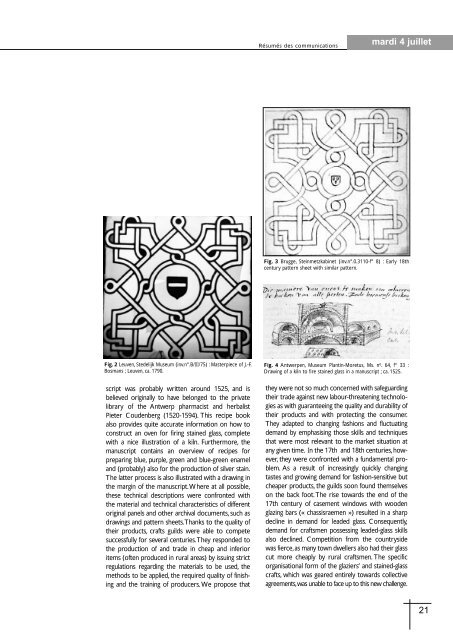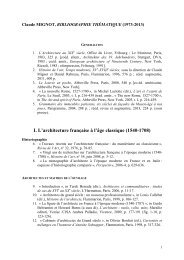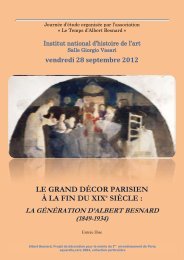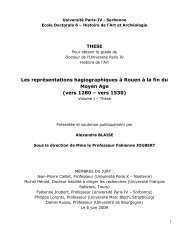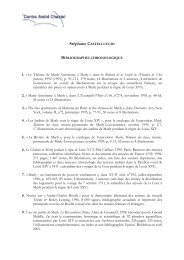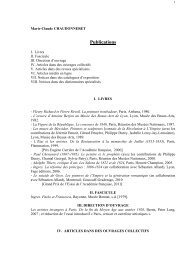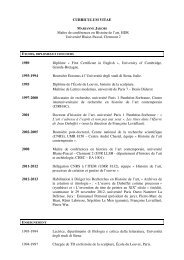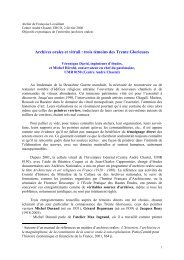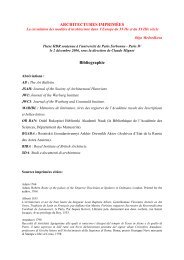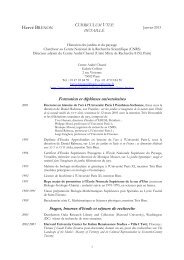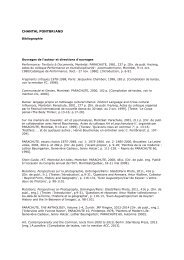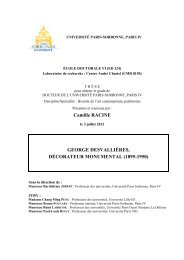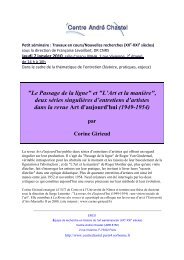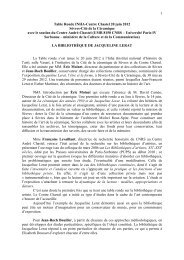mardi 4 juilletRésumés des communicationsJoost Caen et Bert De MunckTechnical Prescriptions for the Production ofStained and Leaded Glass in Guilds’ Ordinancesand Recipe Books in the Southern Netherlandsin the 15th, 16th, 17th and 18thCenturyFig. 1 Gent, Stadsarchief : Ordinance of 6 April 1541, Book of Membership(1338-1733), f° 17r°. One of the first references to enamel paint use in theNetherlands.Historical research into crafts and guilds is all toooften restricted to the confines of archival institutions.Rarely are research findings compared withpreserved artefacts. The present research projectstrives to take a first step towards filling this void bytaking a combined approach, involving the historyof crafts and guilds on the one hand and materialtechnicalresearch into the methods applied bycraftsmen on the other. More in particular, we focuson the glaziers’ and/or the stained-glass crafts.The confrontation of material-technical aspects of(stained) glass and rules and regulations issued bythe guild is relevant to both the history of consumerismand material culture and to the historyof the crafts and their attitude towards technologicalinnovation on the other. As far as materialculture is concerned,long gone are the days that onlythe art-historical value of archaeological and historicalobjects was considered important.The fact thateveryday artefacts also have a historical and socioculturalsignificance follows from a perfectly datablehistorical evolution. By studying the glazing of homesand glass produced by anonymous craftsmen, onecan gain insight into a development whereby prestigiousluxury products gradually had to make way forcheap, fashion-sensitive and mass-produced items.This transition, which unfolded between 1500 and1800, coincided with a changing attitude on the partof the guilds and craftsmen towards established andinnovative techniques. From the perspective of this‘consumption revolution’, the strategies of thenumerous anonymous glassmakers and their corporatistinstitutions may well be more relevant thanthe household names in the history of art.Over the past few years,we have studied guilds’ ordinances,tracts, recipe books and other documentsfrom across the former Southern Netherlands andidentified a large number of technical prescriptionsconcerning the art and craft of stained and leadedglass. The ordinances provide a limited amount ofinformation on glass painting and firing. However, wefound many regulations concerning the quality ofglass and lead, and pertaining to the leading andsoldering as well as the placement of panels.Other documents provide information about glasspaintproduction, glass painting and glass firing. Mostof the 17th and 18th century treatises are wellknown and often quoted. Among these works arethe Dutch translations of A. Neri’s L’ Arte Vetraria(1612) by S.Witgeest (Het nieuw Toneel der Konsten,1679) and of A. Félibien’s Les principes de l’architecture(1676) by F. Le Comte (Het Konst-Cabinet der Bouw-Schilder-Beeldhouw-en Graveerkunde, 1761). Otherbooks were never translated into Dutch, but werenevertheless widely distributed in the SouthernNetherlands, including J. Kunckel’s Ars VitrariaExperimentalis (1689), Baron D’Holbach’s L’artde la verrerie (1752) and P. Le Vieil’s L’art de lapeinture sur verre et de la vitrerie (1774). A veryimportant and early source is a 16th centurySouthern Netherlandish recipe book from thePlantin-Moretus Museum in Antwerp. The manu-20
Résumés des communicationsmardi 4 juilletFig. 3 Brugge, Steinmetzkabinet (inv.n°.0.3110-f° 8) : Early 18thcentury pattern sheet with similar pattern.Fig. 2 Leuven, Stedelijk Museum (inv.n°.B/III/75) : Masterpiece of J.-F.Bosmans ; Leuven, ca. 1790.script was probably written around 1525, and isbelieved originally to have belonged to the privatelibrary of the Antwerp pharmacist and herbalistPieter Coudenberg (1520-1594). This recipe bookalso provides quite accurate information on how toconstruct an oven for firing stained glass, completewith a nice illustration of a kiln. Furthermore, themanuscript contains an overview of recipes forpreparing blue, purple, green and blue-green enameland (probably) also for the production of silver stain.The latter process is also illustrated with a drawing inthe margin of the manuscript.Where at all possible,these technical descriptions were confronted withthe material and technical characteristics of differentoriginal panels and other archival documents, such asdrawings and pattern sheets.Thanks to the quality oftheir products, crafts guilds were able to competesuccessfully for several centuries.They responded tothe production of and trade in cheap and inferioritems (often produced in rural areas) by issuing strictregulations regarding the materials to be used, themethods to be applied, the required quality of finishingand the training of producers.We propose thatFig. 4 Antwerpen, Museum Plantin-Moretus, Ms. n o . 64, f° 33 :Drawing of a kiln to fire stained glass in a manuscript ; ca. 1525.they were not so much concerned with safeguardingtheir trade against new labour-threatening technologiesas with guaranteeing the quality and durability oftheir products and with protecting the consumer.They adapted to changing fashions and fluctuatingdemand by emphasising those skills and techniquesthat were most relevant to the market situation atany given time. In the 17th and 18th centuries,however,they were confronted with a fundamental problem.As a result of increasingly quickly changingtastes and growing demand for fashion-sensitive butcheaper products, the guilds soon found themselveson the back foot.The rise towards the end of the17th century of casement windows with woodenglazing bars (« chassisraemen ») resulted in a sharpdecline in demand for leaded glass. Consequently,demand for craftsmen possessing leaded-glass skillsalso declined. Competition from the countrysidewas fierce,as many town dwellers also had their glasscut more cheaply by rural craftsmen. The specificorganisational form of the glaziers’ and stained-glasscrafts, which was geared entirely towards collectiveagreements,was unable to face up to this new challenge.21


